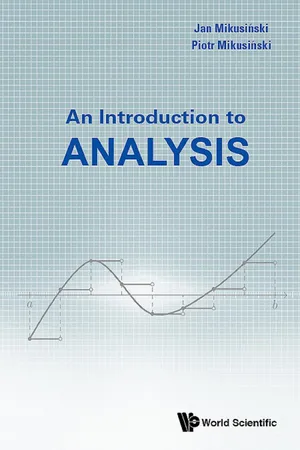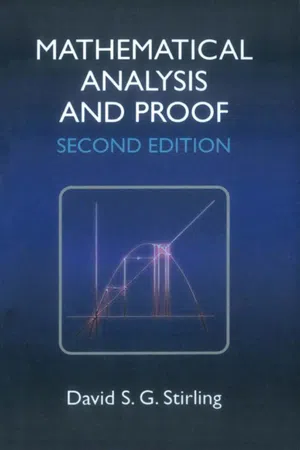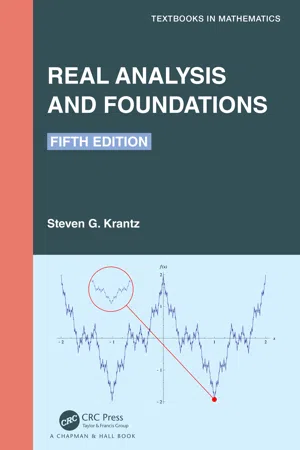Mathematics
The Power Function
The power function is a mathematical concept that represents a relationship where one quantity is raised to the power of another. It is written in the form f(x) = x^n, where x is the base and n is the exponent. The power function is used to model various real-world phenomena and is a fundamental concept in algebra and calculus.
Written by Perlego with AI-assistance
Related key terms
Related key terms
1 of 4
Related key terms
1 of 3
4 Key excerpts on "The Power Function"
- eBook - ePub
- Paul Turner, Justine Wood(Authors)
- 2023(Publication Date)
- Mercury Learning and Information(Publisher)
x is negative, then the output of the function will also be negative.Functions of this form are referred to as power functions since they are defined by raising the variable x to some power given by the parameter a . These functions are straightforward to manipulate, as we will now demonstrate. First, we note that the multiplication of two power functions can be achieved by adding the powers or exponents of the original functions. That is, we have:. (2.7)This is easily demonstrated in the case where a and b are natural numbers with an example. Suppose we wish to multiply by . We have and , and therefore . This generalizes to all cases in which a and b are natural numbers.Another useful property is that raising a power function to some other power is achieved by multiplying the exponents. That is:. (2.8)This can again be illustrated using an example. Suppose we wish to calculate . This can be expressed as . Again, this generalizes for any situation in which a and b are natural numbers.Dividing one power function by another involves the subtraction of powers. Thus, we have. (2.9)For example, if we have , then this can be calculated as . This property allows us to demonstrate the important special case that since, if we have.This extends the set of numbers that the exponent can take from the set of natural numbers to include the number zero.We can extend the set of values for the exponent to include the negative integers as follows. We have already established that when a and b are natural numbers, then for , and we also have . Therefore, dividing by is equivalent to multiplying by , which means that the inverse of can be written as and we have . We can therefore write the equation as This form of the equation is often neater and allows for the simplification of complicated expressions. Note, however, that we need to be careful in specifying the domain of the function. For example, for negative values of a , the input x cannot take on the value zero or the function will not be defined. As an example, consider the case , for , gives us , and we have already seen that this is not defined for - eBook - ePub
- Piotr Mikusi?????ski, Jan Mikusi?????ski;;;(Authors)
- 2017(Publication Date)
- WSPC(Publisher)
Chapter 7
ELEMENTARY FUNCTIONS
In this chapter we give rigorous definitions of elementary functions and establish their properties. By elementary functions we mean here exponential functions, logarithms, trigonometric and inverse trigonometric functions. In elementary calculus these functions are often considered without rigorous definitions. On the other hand, if we want to carefully define these function, we have to choose between different approaches. Our goal was to choose definitions that are natural and mathematically convenient.7.1The exponential function e
xWe now approach the didactic problem of introducing the exponential function whose value at x is ax. This function, perhaps the most important function in calculus, can be introduced in a great many ways. For instance it can be introduced as a generalization of the power anto nonnatural number values of the exponent n. First we introduce axfor negative exponents by declaring that a−n= 1/an. Next we define a1/nas the only positive solution of the equation xn= a.S:But there are values of a for which the equation has no solution, for example x2 = −1.T:Yes, and for that reason we assume that a > 0. We have to remember that the exponential function is an extension of the power with positive base.S:How do we know that a solution exists for a > 0 and that it is unique?T:This will be shown in the next section.S:And how do we define axfor other values of x?T:The exponents m/n are introduced by am/n= (a1/n)m. Finally, if x is an irrational number we approximate it by a sequence of rational numbers xn and then we prove that the sequence (ax) is convergent. The value of anxis defined as the limit of (axn).S:Since there are infinitely many sequences of rational numbers convergent to x, we may obtain infinitely many values for ax.T:No. One can prove that the limit does not depend on the choice of the sequence converging to x - eBook - ePub
- David S G Stirling(Author)
- 2009(Publication Date)
- Woodhead Publishing(Publisher)
12Functions Defined by Power Series
12.1 Introduction
We are led naturally to the study of those functions which can be represented as the sums of power series for two reasons. Taylor’s Theorem allows us to express a function f as a sum of finitely many terms of the form (x – a )n f(n )(a )/n ! plus a remainder, and we may observe that in some cases the remainder tends to zero as the number of terms increases; this may be thought of as expressing f as a sum of the simpler functions (x – a )n . More significantly, we arrive at power series by attempting to find functions with desirable properties, usually arising from differential equations. If we wish to find a function equal to its own derivative, then if this function were expressible in the form ∑∞n =0a n x n , and if the derivative turned out to equal the expression obtained by differentiating term by term, ∑∞n =1na n xn −1, then the equality of the function and its derivative would be guaranteed if we were to choose the coefficientsanso that these two series were identical, that is,an = a0 /n !. Assuming this outline programme is correct and, in particular, that the interchange of the limits involved in taking derivatives of infinite sums can be justified, this yields a simple technique for producing various special functions required in everyday mathematics.In what follows we shall consider functions of the form ∑∞n =0a n x n whereandoes not depend on x and the term a 0 x 0 is understood to mean a 0 . By a simple change of variable this allows us to consider functions of the form ∑ a n (x − a )n .The first thing to recall is the result of Lemma 8.11, that if the power series ∑ a n w n converges, then ∑ a n x n converges if |x | < |w - eBook - ePub
- Steven G. Krantz(Author)
- 2022(Publication Date)
- Chapman and Hall/CRC(Publisher)
that e x > c N ⋅ x N when x > 0. Proof: The first three statements are obvious from the power series expansion for the exponential function. If s < t then the Mean Value Theorem tells us that there is a number ξ between s and t such that e t − e s = (t − s) ⋅ e ξ > 0 ; hence the exponential function is strictly increasing. By inspecting the power series we see that e x > 1 + x hence e x increases to +∞. Since e x ⋅ e − x = 1 we conclude that e − x tends to 0 as x → + ∞. Thus the graph of the exponential function is asymptotic to the negative x -axis. Finally, by inspecting the power series for e x, we see that the last assertion is true with c N = 1 / N !. □ Example 9.27: Let us think about 9.26(c). Which functions satisfy y ′ = y ? We may rewrite this equation as y ′ y = 1. Now integrate both sides to obtain ln | y | = x + C. Exponentiation now yields | y | = e C ⋅ e x. If we assume that y is a positive function then we can erase the absolute value signs on the left-hand side. And we can rename the constant e C with the simpler name K. So our equation is y = K e x. We have discovered that, up to a constant factor, the exponential function is the only function that satisfies 9.26(c). □ Now we turn to the trigonometric functions. The definition of the trigonometric functions that is found in calculus texts is unsatisfactory because it relies too heavily on a picture and because the continual need to subtract off superfluous multiples of 2 π is clumsy. We have nevertheless used the trigonometric functions in earlier chapters to illustrate various concepts. It is time now to give a rigorous definition of the trigonometric functions that is independent of these earlier considerations. Definition 9.28: The power series ∑ j = 0 ∞ (− 1) j x 2 j + 1 (2 j + 1) ! converges at every point of the real line (by the Ratio Test)
Index pages curate the most relevant extracts from our library of academic textbooks. They’ve been created using an in-house natural language model (NLM), each adding context and meaning to key research topics.
Explore more topic indexes
Explore more topic indexes
1 of 6
Explore more topic indexes
1 of 4



